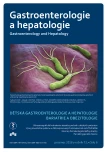Hemorrhage as a complication of chronic pancreatitis
Authors:
Kancnýř J.; Kovala P.; Kremer M.
Authors‘ workplace:
Interna, Městská nemocnice Ostrava, p. o.
Published in:
Gastroent Hepatol 2018; 72(6): 527-530
Category:
doi:
https://doi.org/10.14735/amgh2018527
Overview
Hemorrhage due to chronic pancreatitis is an unusual complication, which can be life threatening, depending on its localization and intensity. Early diagnosis and hemorrhage localization are very important. Choice of the appropriate intervention depends on the actual hemodynamic condition and technical feasibility. This case report describes a patient with a long term history of chronic pancreatitis, complicated by a pancreatic head pseudocyst. The patient came to the hospital because of acute abdominal pain. During the examination, enlargement of the pseudocyst was detected, which was accompanied by oppression of the extrahepatic biliary duct. An intrapseudocyst hemorrhage was suspected. After CT revealed leakage of the contrast agent into the pseudocyst lumen, angiography was employed, which demonstrated coiling of a broken artery. After this, endoscopic retrograde cholangiopancreatography with biliary stent insertion to the d. choledochus was performed. During application of the contrast agent to the biliary ducts, the pseudocysts lumen was filled with the contrast agent, making transpapillary drainage possible using a mono pigtail. Complete regression of the pancreatic pseudocyst and spontaneous elimination of the mono pigtail were observed during a subsequent examination.
Keywords:
chronic pancreatitis – pancreatic pseudocyst – haemorrhage – angiography
Submitted: 23. 3. 2018
Accepted: 3. 7. 2018
The authors declare they have no potential conflicts of interest concerning drugs, products, or services used in the study.
The Editorial Board declares that the manuscript met the ICMJE „uniform requirements“ for biomedical papers.
Sources
1. Bouassida M, Benali M, Charrada H et al. Gastrointestinal bleeding due to an erosion of the superior mesenteric artery: an exceptional fatal complication of pancreatic pseudocyst. Pan Afr Med J 2012; 12 : 62.
2. Houska A, Závada F, Lacman J et al. Neobvyklá komplikace chronické pankreatitidy. Gastroent Hepatol 2011; 65(3): 154– 156.
3. Garcea G, Krebs M, Lloyd T et al. Haemorrhage from pancreatic pseudocysts presenting as upper gastrointestinal haemorrhage. Asian J Surg 2004; 27(2): 137– 140. doi: 10.1016/ S1015-9584(09)60328-6.
4. Ammori BJ, Madan M, Alexander DJ. Haemorrhagic complications of pancreatitis: presentation, diagnosis and management. Ann R Coll Surg Engl 1998; 80(5): 316– 325.
5. Novacic K, Vidjak V, Suknaic S et al. Embolization of a large pancreatic pseudoaneurysm converted from pseudocyst (hemorrhagic pseudocyst). JOP 2008; 9(3): 317– 321.
6. Novotný I, Boudný J, Kala Z. Hemosuccus pancreaticus jako komplikace akutní exacerbace chronické pankreatitidy. Česk Slov Gastroenterol Hepatol 2004; 58(1): 16– 20.
7. Zarin M, Ali S, Majid A et al. Gastroduodenal artery aneurysm – post traumatic pancreatic pseudocyst drainage – an interesting case. Int J Surg Case Rep 2018; 42 : 82– 84. doi: 10.1016/ j.ijscr.2017.11.049.
8. Yu P, Gong J. Hemosuccus pancreaticus: A mini-review. Ann Med Surg 2018; 28 : 45– 48. doi: 10.1016/ j.amsu.2018.03.002.
9. Peynircioğlu B, Karaosmanoğlu AD, Idilman IS et al. Intrapancreatic pseudoaneurysm causing massive gastrointestinal hemorrhage and chronic pancreatitis. Turk J Gastroenterol 2015; 26(3): 270– 273. doi: 10.5152/ tjg.2015.6548.
10. Rana SS, Singhal M, Sharma A et al. Success-ful hemostasis of arterial bleeding in chronic pseudocyst by direct endoscopic injection of N-butyl-2-cyanoacrylate in the pseudoaneurysm. Gastrointest Endosc 2015; 81(4): 1046– 1047. doi: 10.1016/ j.gie.2014.09.057.
11. Fejfar T, Vaňásek T, Brůha R et al. Léčba krvácení v důsledku portální hypertenze při jaterní cirhóze – aktualizace doporučených postupů ČHS ČLS JEP. Gastroent Hepatol 2017; 71(2): 105–116. doi:10.14735/amgh2017105.
12. Szpakowicz J, Szpakowitz P, Urbanik A et al. Splenic artery pseudoaneurysm rupture into a pancreatic pseudocyst with its subsequent perforation as the cause of a massive intra-abdominal bleeding – case report. Pol Przegl Chir 2016; 88(6): 350– 355. doi: 10.1515/ pjs-2016-0075.
Labels
Paediatric gastroenterology Gastroenterology and hepatology SurgeryArticle was published in
Gastroenterology and Hepatology

2018 Issue 6
- Metamizole vs. Tramadol in Postoperative Analgesia
- The Importance of Limosilactobacillus reuteri in Administration to Diabetics with Gingivitis
- Safety and Tolerance of Metamizole in Postoperative Analgesia in Children
- Metamizole in perioperative treatment in children under 14 years – results of a questionnaire survey from practice
Most read in this issue
- Meckel’s diverticulum as a cause of abdominal emergency
- Hepatopathy as the first manifestation of systemic AL amyloidosis
- Wilson’s disease in childhood – two case reports
- News of pharmacological treatment of obesity
